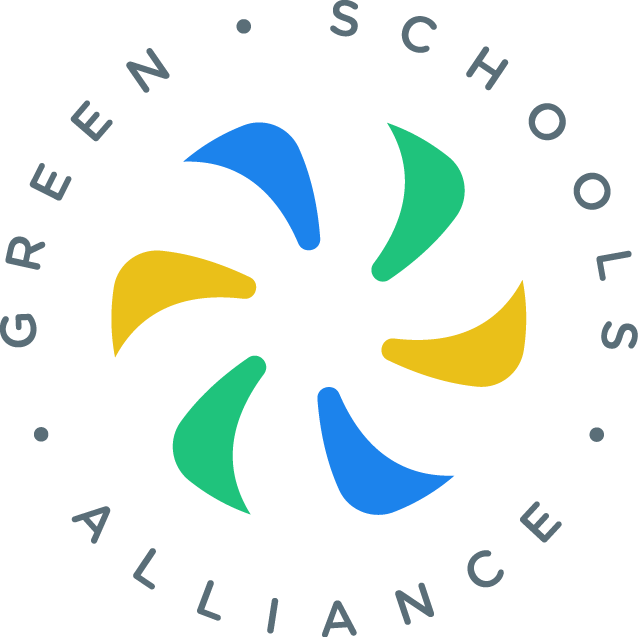
Physical Place:
Reduce, Reuse,
Rethink Recycle
START Metric #32:
Waste Diversion
⬅ Back
Ideas & Resources

Diverting municipal solid waste (MSW) from landfills and incinerators is a critical component of sustainable waste management. In 2018, the United States generated approximately 292.4 million tons of MSW, equating to about 4.9 pounds per person per day in the USA alone (Environmental Protection Agency).
Of this, only 32.1% was recycled or composted, highlighting significant room for improvement in waste diversion efforts. Globally, waste generation is projected to increase by 70% from 2016 levels by 2050, reaching 3.4 billion tons annually. (Data Topics)
Implementing practices such as recycling, composting, donating, exchanging, or reselling can significantly reduce the environmental footprint of schools. These efforts conserve natural resources and reduce greenhouse gas emissions associated with waste decomposition in landfills. Engaging the school community in waste diversion initiatives fosters environmental stewardship and promotes sustainable habits among students and staff.

Strategies for Diverting Municipal Solid Waste
NOTE: This is not a prescriptive list; it just offers ideas to inspire action and can be tailored to fit the unique needs of each school.
Implement Comprehensive Recycling Programs
Provide clearly labeled bins for paper, plastics, metals, and glass throughout the school.
Educate students and staff on proper recycling practices to reduce contamination.
Establish Composting Systems
Set up compost bins for food scraps and organic waste from cafeterias and classrooms.
Use the compost produced in school gardens or landscaping projects.
Organize Donation Drives
Collect gently used clothing, books, and supplies for donation to local charities.
Encourage the school community to participate in regular donation events.
Create Exchange or Swap Events
Host events where students and staff can exchange items like clothing, books, or electronics.
Promote a culture of reuse and reduce the demand for new products.
Resell Unneeded Items
Sell surplus equipment, furniture, or supplies through online platforms or school-organized sales.
Use proceeds to fund school programs or sustainability initiatives.
Integrate Waste Diversion into Curriculum
Include lessons on waste management, recycling, and environmental impact in relevant subjects.
Engage students in projects that promote waste reduction and resource conservation.
Partner with Local Waste Management Services
Collaborate with local councils or waste management companies to enhance recycling and composting efforts.
Stay informed about community resources and programs that support waste diversion.
Monitor and Evaluate Waste Reduction Efforts
Track the volume of waste diverted from landfills to assess the effectiveness of initiatives.
Use data to set goals and make informed decisions about future waste management strategies.
Encourage Reusable Materials
Promote the use of reusable containers, utensils, and water bottles within the school.
Implement policies that discourage single-use plastics and other disposable items.
Engage the School Community
Involve students, staff, and families in waste diversion programs through workshops, campaigns, and volunteer opportunities.
Recognize and celebrate the community's contributions to waste reduction efforts.
‘How To’ Guides
-

Cafeteria Sorting Station Guide
Steps from StopWaste to set up a 3-stream sorting, recycling and composting program and when applicable, food share program.
-

Food Waste Diversion Guide
From MassDEP, a framework to help you manage and select the best strategies for food waste diversion at your school.
-

Lunch Waste Audit Resource
The Center for Environmental Health’s steps for running a cafeteria Waste Audit, including an Audit Data Sheet and Waste Chart Guide.
-

Paper Waste Reduction Guide
Turning the Page: A Behavior Change Toolkit for Reducing Paper Use, from Aashe and Root Solutions, can help you develop and implement paper reduction strategies.
-

A Guide for Implementing a School Recycling Program
From askHRgreen, a guide to preparing for recycling, understanding collection systems, starting and promoting your system and evaluating its success.
-

How to Start a School Recycling Program
From the Green Team, a toolkit to help you build support, plan, implement and evaluate a school recycling program.
Additional Resources
-

Case Study: Material Generated, Discarded and Recovered at Schools
A case study to help address the questions: How much waste is created by a school? How much of it could be prevented, recycled or composted?
-
-
Schools hold the key to a healthy, sustainable and regenerative future.
They are role-models and incubators that that nurture, educate and prepare each generation for adult life.
Schools have a unique opportunity and profound responsibility to become part the transition to a sustainable, regenerative future in which people and planet can thrive.
But how do we get there?

START: Sustainability Tracking, Analytics & Roadmap Tool was created by schools, for schools, to help them develop comprehensive programs for step-by-step progress towards sustainability, regenerative practice, and student empowerment.
START provides a Roadmap for School Sustainability:
It breaks down school sustainability into clear actions (‘metrics’), such as Minimizing Waste, Reducing Greenhouse Gas Emissions, and supporting Sustainable Transportation options.
However, research shows it’s not enough for a school to simply reduce its environmental impact.
Students and staff also need to learn about sustainability, and practice it in day-to-day activities, because this impacts their attitudes and behaviors when they leave school. That’s why START includes metrics like Sustainability Events for Students, Sustainability Course Content, and Sustainable Purchasing Practices.
How sustainable is our school now?
Schools use START to measure how sustainable they are now. A school’s START team investigates how their school currently operates to find their ‘sustainability baseline’ for each metric. For example, is our school a beginner, intermediate or advanced in sustainable water use? START enables schools to benchmark, track and visualize their current sustainability levels, as well as hard data around their waste, water, energy and greenhouse gas emissions.
Where should we go next, and do we collaborate for success?
What do we need to do to ‘level up’ in each metric? Once schools have their baselines, START helps them to set goals and plan for progress. START provides a central hub for school members to collaborate, document, and plan their school’s sustainability journey.

START is a subscription-based Whole School Sustainability dashboard.
It requires at least one adult school member to create a school’s START account, but it will need a team (students, teachers and staff) to grow a Whole School Sustainability program.
Interested schools can sign up for a demo or apply to set up an account.
Learn more about START here, and consider sharing the brochure with your school.
Let’s create a better future, one school at a time.
Contact us at guides@greenschoolsalliance.org if you have a free resource to contribute or recommend that can help schools take action around this specific sustainability metric.






